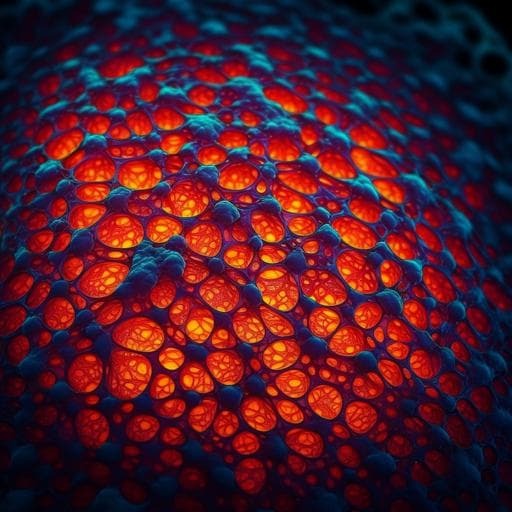
Engineering and Technology
Machine intelligence accelerated design of conductive MXene aerogels with programmable properties
S. Shrestha, K. J. Barvenik, et al.
This groundbreaking research by Snehi Shrestha and colleagues introduces an innovative workflow combining robotics and machine learning to design ultralight conductive aerogels with tailored properties. Their automated approach enables the prediction and inverse design of aerogels, paving the way for applications in wearable thermal management.
~3 min • Beginner • English
Introduction
Conductive aerogels are attractive for pressure sensing, EMI shielding, thermal insulation, and wearable heating due to their ultralight, mechanically tunable, and electrically conductive nature. They are typically fabricated by preparing aqueous mixtures of conductive nanomaterials (e.g., MXene), functional fillers (e.g., cellulose nanofibers), binders (e.g., gelatin), and crosslinkers (e.g., glutaraldehyde), followed by freeze-drying. Adjusting component ratios and mixture loading tunes properties, yet the composition–structure–property relationships are complex and underexplored. Conventional development requires labor-intensive, iterative experimentation to identify optimal fabrication parameters. The research question is whether integrating collaborative robotics with AI/ML can efficiently map and exploit the high-dimensional fabrication space to predict and inversely design MXene-based conductive aerogels with user-specified mechanical (compressive strength) and electrical (resistance) properties, while elucidating key governing factors.
Literature Review
AI/ML has advanced materials discovery where abundant data or simulations exist (e.g., batteries, catalysis, gene editing). For conductive aerogels, progress is hindered by limited, heterogeneous datasets due to non-standardized fabrication protocols and a frequent focus on optimizing single properties (electrical or mechanical) rather than understanding their interdependence. Prior MXene-based aerogel studies often used one-factor-at-a-time experimental designs, yielding system-specific insights and sometimes contradictory trends. High-throughput robotic platforms have been used to navigate multi-DOF spaces, but typically target narrow optima, requiring new optimization rounds for new objectives. This work addresses data scarcity and multi-property coupling by combining robotics, active learning, and data augmentation to build a generalizable, accurate predictor across the entire feasible parameter space and to automate inverse design.
Methodology
The workflow comprises three major phases: (1) feasible space definition, (2) active learning with robotics and data augmentation, and (3) model interpretation and validation.
- Feasible parameter space via SVM: An OT-2 pipetting robot prepared 264 MXene/CNF/gelatin mixtures across ratios and mixture loadings (2.5–10.0 mg mL−1), optionally incorporating GA crosslinker. After freeze-drying, samples were graded based on structural integrity and monolithic nature into A (intact), B (fragmented), or C (inconsistent pieces), yielding 201 A, 49 B, 14 C. These labels trained an SVM classifier to predict A-grade probability (95% accuracy on held-out data). Heatmaps of A-grade probability across ratios and loadings were generated; with a 65% threshold, the feasible space was defined. The feasible area shrank as loading decreased (e.g., from 83.7% to 48.6% when loading decreased from 10.0 to 2.5 mg mL−1). XPS analyses indicated GA primarily formed covalent bonds among CNFs; MXene Ti–C integrity was preserved.
- Active learning and robotics-accelerated data acquisition: Within the feasible space, 8 active learning loops were executed. Each loop began with 20 robot-prepared recipes (including ratio and loading), freeze-dried to aerogels. Properties measured: compressive stress at 30% strain (σ30) from stress–strain curves, and initial electrical resistance (R0) via a two-electrode setup (1 cm gap). A UR5e robotic arm integrated with an Instron tester automated compression testing (>400 aerogels tested as 3–4 replicates per point; ~81 h total; ~12 min per sample). Each loop took ~2.5 days (2 h OT-2 pipetting, 48 h freeze-drying, 4 h autonomous testing, 4 h model training).
- Data augmentation (UIP): To mitigate overfitting and improve efficiency, virtual data were synthesized near real data using Gaussian perturbations guided by observed variability in composition labels and measurement noise in σ30 and R0. Ultimately, 162 real data points and ~160,000 virtual points (1:1000 ratio) trained an ANN with 4-fold cross-validation. An acquisition function A Score = L/σ (Euclidean distance to in-model points divided by model prediction variance) prioritized least-familiar points for subsequent loops.
- Model benchmarking and sampling strategies: ANN performance (MAE for σ30, MRE for R0) was compared to linear regression, decision tree, gradient-boosted trees, and random forest. Sampling strategies (random, Latin hypercube, active learning) were compared over three cycles of five experiments each; success rate in recommending A-grade recipes and post-augmentation model MAE were evaluated.
- Model interpretation and FE simulations: SHAP was used to quantify feature contributions of MXene, CNF, gelatin, GA, and mixture loading on σ30 and R0. Correlations were validated by experiments at fixed ratios or loadings. Finite element (ABAQUS/CAE 2020) 2D plane strain models (4×4 supercells with periodic boundaries, randomly seeded wall discontinuities) captured microstructural effects (pore size, wall thickness, fracture density) on σ30 under 30% compression. Simulated σ30 for low/medium/high-density (via loading 5.0/7.5/10.0 mg mL−1 at fixed 80/20/0/−) matched experiments and visualized stress distributions.
- Demonstration: The champion ANN model executed inverse design to find high-strength (σ30 ≥ 10 kPa) and high-strength, conductive (σ30 > 10 kPa and R0 < 10 Ω) aerogels, and to discover a strain-insensitive aerogel for wearable heating with low pressure sensitivity and stable Joule heating under compression. Thermal conductivity and wearable demonstration were performed.
Key Findings
- Feasible space definition: 264 recipes produced 201 A-grade, 49 B-grade, 14 C-grade aerogels. SVM classifier predicted A-grade probability with 95% accuracy; a 65% threshold defined feasible regions. Feasible area decreased with lower mixture loading (e.g., 83.7% at 10 mg mL−1 to 48.6% at 2.5 mg mL−1).
- Data acquisition and model performance: 8 active learning loops yielded 162 unique aerogel data points. With 1:1000 virtual-to-real augmentation (~160,000 virtual points), ANN prediction accuracy improved across loops: σ30 MAE decreased from 2.5 to 1.5 kPa; R0 MRE decreased from 49.0% to 18.4%, approaching experimental variability (σ30 ~1.1 kPa; R0 ~10.1%). Without augmentation, ANN errors were higher (MAE >1.9 kPa; MRE >37%). Increasing virtual-to-real ratio to 100 and 1000 reduced MAE to 1.8 and 1.5 kPa and MRE to 21.5% and 18.4%.
- Sampling comparison: Active learning sampling achieved >95% success in recommending A-grade recipes vs 80% (random) and 67% (Latin hypercube). Post-augmentation model trained on actively sampled data achieved lowest MAE (1.1 kPa) vs 5.8 and 5.0 kPa for random and Latin hypercube after three cycles.
- Two-way design: Forward predictions of σ30 and R0 for multiple recipes (#1–#8) matched experiments closely. Inverse design identified recipes meeting targets: high-strength (σ30 ≥ 10 kPa; e.g., #9–#10) and high-strength, conductive (σ30 > 10 kPa and R0 < 10 Ω; e.g., #11–#14). Achievable ranges spanned ~0.1 < σ30 < 16.0 kPa and 10^0 < R0 < 100 Ω.
- SHAP insights: Mixture loading had the widest SHAP range on σ30 (−1.00 to +0.97), indicating dominant influence on compressive strength; MXene loading most strongly affected R0 (−0.94 to +0.97). Experiments confirmed mixture loading strongly correlates with density and σ30; at fixed loading, composition changes produced smaller σ30 shifts.
- FE validation: 2D FE models for low/medium/high-density (fixed 80/20/0/−; loadings 5.0/7.5/10.0 mg mL−1) reproduced experimental σ30 and revealed stress distributions: high-density exhibited smaller pores and more uniform stress; lower density showed larger pores, higher local displacements, and lower σ30.
- Strain-insensitive aerogel discovery: Recipe #16 (MXene/CNF/gelatin/GA 78/13/9/−; loading 7.5 mg mL−1) delivered σ30 = 4.0 kPa, R0 = 1.7 Ω, pressure sensitivity S = 0.02 kPa−1, and only 0.9% relative resistance change over 100 cycles at 20% compression. Joule heating reached ~29, 37, 51, and 70 °C at 0.5, 1.0, 1.5, and 2.0 V within 300 s, with strain-unresponsive heating/cooling over 100 cycles at 1.0 and 1.5 V. Density and thermal conductivity were 10.1 mg cm−3 and 0.034 W m−1 K−1. A jacket demonstration showed localized on-demand heating at 1.5 V.
Discussion
The study demonstrates that integrating collaborative robotics with AI/ML effectively addresses the combinatorial complexity of fabricating conductive MXene aerogels with targeted properties. The SVM-defined feasible space prevents exploration of fragile, unscalable regions, while active learning strategically samples unfamiliar, informative points, improving data efficiency and model accuracy. Data augmentation mitigates overfitting from small experimental datasets, enabling a robust ANN that generalizes across the feasible space. Interpretable analyses (SHAP) reveal mixture loading (and thereby aerogel density) as the dominant driver of compressive strength, while MXene loading predominantly controls electrical resistance. FE simulations corroborate mechanistic links between microstructure, stress distribution, and strength. The champion model performs two-way design: accurate forward prediction and automated inverse design to meet specified multi-property targets, exemplified by discovering a strain-insensitive aerogel with stable Joule heating suitable for wearable applications. The workflow is adaptable to broader nanoscience domains where high-DOF parameter spaces, limited standardized data, and coupled properties pose similar challenges.
Conclusion
An integrated robotics/ML workflow was established to rapidly design MXene-based conductive aerogels with programmable mechanical and electrical properties. Automated mixture preparation (OT-2) and autonomous mechanical testing (UR5e + Instron) enabled efficient data collection; an SVM classifier defined a feasible fabrication space; active learning with data augmentation built a high-accuracy ANN that supports forward prediction and inverse design across the entire parameter space. Model interpretation (SHAP) and FE simulations elucidated key structure–property relationships, particularly the strong influence of mixture loading (density) on compressive strength and MXene loading on electrical resistance. The approach successfully identified a strain-insensitive aerogel for wearable thermal management with high conductivity, tailored strength, ultralow pressure sensitivity, and stable Joule heating. This synergistic workflow can be extended to other material systems (e.g., tactile sensors, stretchable conductors, catalysts, and electrolytes) to accelerate discovery and customization.
Limitations
- Data scarcity and augmentation: The experimental dataset (162 real points) required extensive virtual augmentation (1:1000) to prevent overfitting; model performance depends on realistic noise modeling and may degrade if augmentation is mis-specified.
- Human-in-the-loop steps: Expert evaluation was necessary for grading aerogel integrity, setting the A-grade probability threshold, curating suitable property labels (e.g., using σ30 instead of full stress–strain curves), and guiding augmentation parameters.
- Process automation gaps: Freeze-drying was not fully automated, limiting throughput; the pipeline still requires manual steps and oversight.
- Computational trade-offs: Excessively high virtual-to-real ratios (≥5000) substantially increased training time (>1–2 days) without proportional accuracy gains.
- Model scope: The prediction space is constrained to the chosen components (MXene, CNF, gelatin, GA) and loading range (2.5–10 mg mL−1); extrapolation beyond the feasible space or to different chemistries requires further data and potential retraining.
- FE modeling simplifications: 2D plane strain representations and tuned discontinuity parameters approximate complex 3D microstructures; while trends matched experiments, fine-scale behaviors may require more detailed 3D modeling.
Related Publications
Explore these studies to deepen your understanding of the subject.







